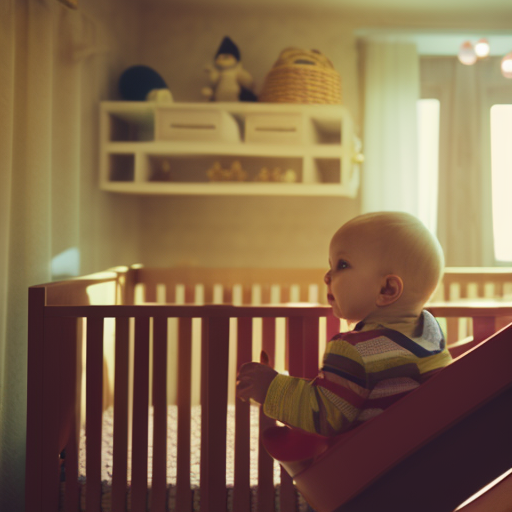"Cherishing Little Steps - A Haven for Baby and Family Journeys"
Understanding Infant Sleep Cycles
You’ve probably heard the saying, ‘sleep like a baby.’ But what does that really mean? Understanding infant sleep cycles can be a bit of a puzzle, but fear not, we’ve got you covered.
In this discussion, we’ll uncover the secrets behind a baby’s sleep patterns, explore the different stages of sleep they go through, and reveal how long these cycles typically last.
But that’s not all. We’ll also delve into recognizing signs of sleepiness, dealing with those frequent night wakings, navigating sleep regression, and creating a calming bedtime routine.
So, get ready to discover the fascinating world of infant sleep cycles and gain some valuable insights into your little one’s slumber.
Key Takeaways
- Newborn sleep patterns differ from adult sleep patterns
- Infants spend more time in REM sleep for brain development
- Sleep-wake cycles are not regulated by circadian rhythms yet
- Infant sleep cycles last around 50-60 minutes in early months
The Basics of Infant Sleep Cycles

Understanding the basics of infant sleep cycles is crucial for parents to ensure their baby gets the restful sleep they need for healthy development. One important aspect of infant sleep is establishing a consistent nap schedule. Naps provide much-needed rest and help regulate the baby’s sleep-wake cycle. By following a regular nap routine, parents can help their baby develop good sleep habits and prevent overtiredness, which can lead to fussiness and difficulty falling asleep.
Another key factor in promoting healthy sleep is managing nighttime sleep associations. Babies often develop associations between certain actions or objects and falling asleep, such as being rocked or having a pacifier. While these associations can initially help the baby fall asleep, they can become problematic if the baby relies on them to fall back asleep during the night.
To avoid this, it’s important to gradually transition the baby away from sleep associations and encourage self-soothing skills. This can be done by gradually reducing the use of sleep aids and allowing the baby to fall asleep independently.
The Science Behind Newborn Sleep Patterns

To comprehend the science behind newborn sleep patterns, it’s essential for parents to grasp the intricate workings of their baby’s natural sleep cycles. Understanding how and why newborns sleep the way they do can help alleviate some of the stress and frustration that comes with sleep deprivation.
Here are a few key points to consider:
-
Newborn sleep patterns are different from adult sleep patterns. Infants spend more time in rapid eye movement (REM) sleep, which is vital for brain development. This means they’ve shorter sleep cycles and wake up more frequently.
-
Babies have a natural tendency to fall asleep and wake up throughout the day and night. Their sleep patterns aren’t yet regulated by circadian rhythms, which control sleep-wake cycles in adults.
-
Newborns have a higher need for sleep compared to older infants and toddlers. They require around 14 to 17 hours of sleep per day, but their sleep is usually fragmented into shorter periods.
-
Sleep deprivation is common for both babies and parents during the newborn phase. It’s important to prioritize rest and establish healthy sleep habits to promote better sleep for the entire family.
Understanding the Different Stages of Sleep

During sleep, your baby goes through different stages that play a crucial role in their development and well-being. Understanding these stages can help you promote healthy sleep habits and prevent sleep deprivation for both you and your baby.
The different stages of sleep can be categorized into two main types: REM (rapid eye movement) sleep and non-REM sleep. REM sleep is the stage when most dreaming occurs, while non-REM sleep is divided into three stages: N1, N2, and N3.
| Sleep Stage | Description | Characteristics |
|---|---|---|
| REM Sleep | Active sleep stage where dreaming occurs | Rapid eye movement, increased brain activity, irregular breathing, and twitching |
| N1 (Light Sleep) | Transition stage from wakefulness to sleep | Slow eye movements, muscle relaxation, and may be easily awakened |
| N2 (Light Sleep) | Deeper sleep stage | Decreased eye movement, slower brain waves, and occasional bursts of rapid brain activity |
| N3 (Deep Sleep) | Restorative sleep stage | Slow brain waves, limited muscle activity, and difficult to wake up |
Understanding these stages helps you recognize when your baby is in a deep sleep stage and when they may be more easily awakened. By promoting healthy sleep habits and creating a soothing sleep environment, you can help your baby establish a consistent sleep routine and reduce the risk of sleep deprivation for both you and your little one.
How Long Do Infant Sleep Cycles Last?

As you explore the topic of infant sleep cycles, it’s important to understand the duration of these cycles for your baby’s well-being. Here’s what you need to know about how long infant sleep cycles typically last:
-
Average duration: Infant sleep cycles usually last around 50-60 minutes in the early months. As your baby grows, these cycles gradually lengthen to about 60-90 minutes by the age of six months.
-
Sleep cycle stages: Each sleep cycle consists of different stages. The two main stages are non-rapid eye movement (NREM) sleep and rapid eye movement (REM) sleep. NREM sleep is further divided into three stages: drowsiness, light sleep, and deep sleep. REM sleep is the stage where dreams occur and is often associated with more active brain activity.
-
Variances: It’s important to note that every baby is unique, and sleep cycle durations can vary. Some babies may have shorter or longer sleep cycles than the average. Additionally, the duration of sleep cycles can be influenced by factors such as age, development, and individual sleep patterns.
Understanding the average duration of infant sleep cycles and the different stages within them can help you navigate your baby’s sleep patterns more effectively. By recognizing their sleep cues and creating a conducive sleep environment, you can support your little one’s healthy sleep habits.
Recognizing Signs of Sleepiness in Babies

Recognize the signs of sleepiness in your baby to ensure they get the rest they need for healthy development. Understanding the impact of sleep deprivation on infants’ development is crucial in promoting their well-being. Babies have different ways of showing that they’re tired and ready for sleep. By recognizing these signs, you can help create a sleep-friendly environment and establish healthy sleep habits.
One common sign of sleepiness in babies is rubbing their eyes or pulling at their ears. This can indicate that they’re feeling tired and ready to rest. Another sign is yawning, which is a clear indication that your baby needs to sleep. Some babies may also become fussy or irritable when they’re sleepy. They may cry more than usual and have difficulty settling down.
Other signs of sleepiness in babies include decreased activity and decreased interest in their surroundings. They may become less engaged and show a lack of enthusiasm for playtime. It’s important to note that every baby is different, and they may exhibit their own unique signs of sleepiness.
Tips for Establishing Healthy Sleep Habits

To promote healthy sleep habits in your baby, it’s important to establish a consistent bedtime routine that supports their natural sleep cycles. By following these tips, you can help your little one develop good sleep habits and enjoy more restful nights.
-
Create a relaxing bedtime routine: Establish a pre-sleep routine that includes activities like a warm bath, soothing massage, or gentle lullabies. This signals to your baby that it’s time to wind down and prepare for sleep.
-
Stick to a consistent schedule: Babies thrive on routine, so try to establish a regular sleep schedule. Aim for a consistent bedtime and wake-up time, even on weekends, to help regulate their internal clock.
-
Create a sleep-friendly environment: Make sure your baby’s sleep environment is comfortable, quiet, and dark. Use a white noise machine or soft music to drown out any outside noise and promote relaxation.
-
Encourage self-soothing: Teach your baby to fall asleep independently by putting them down drowsy but awake. This helps them learn how to soothe themselves back to sleep if they wake up during the night.
Dealing With Frequent Night Wakings

If your baby is experiencing frequent night wakings, there are strategies you can implement to help them sleep more consistently through the night. Dealing with sleep training and coping with sleep deprivation can be challenging, but with the right approach, you can improve your baby’s sleep quality and your own well-being.
One effective strategy is to establish a consistent bedtime routine. This can include activities such as a warm bath, reading a bedtime story, or singing a lullaby. A predictable routine helps signal to your baby that it’s time to sleep.
Another approach is to gradually teach your baby to fall asleep on their own. This can be done through techniques like fading, where you gradually decrease your presence during bedtime, or by using the ‘cry-it-out’ method, where you allow your baby to self-soothe.
It’s important to remember that every baby is different, so finding the right sleep training method may require some trial and error. Additionally, it’s crucial to take care of yourself and prioritize self-care. Seeking support from loved ones or joining a support group can help alleviate the stress of sleep deprivation.
Navigating Sleep Regression in Infants

As your baby grows and develops, they may go through a phase of sleep regression that can disrupt their previously established sleep patterns. Navigating sleep regression can be challenging, but with some strategies in place, you can manage sleep disruptions more effectively.
Here are some tips to help you navigate sleep regression and manage sleep disruptions:
-
Stick to a consistent bedtime routine: Establishing a soothing bedtime routine can signal to your baby that it’s time for sleep. Consistency is key, so try to follow the same routine every night.
-
Provide a sleep-friendly environment: Create a calm and comfortable sleep environment for your baby. Ensure the room is dark, quiet, and at a comfortable temperature.
-
Offer comfort and reassurance: During sleep regression, your baby may need extra comfort and reassurance. Respond to their needs promptly, whether it’s offering a gentle pat, a soothing voice, or a comforting touch.
-
Avoid creating new sleep associations: While it’s important to provide comfort, try to avoid creating new sleep associations that may become difficult to break later on. Encourage your baby to self-soothe and fall back asleep independently.
Creating a Calming Bedtime Routine

Establishing a consistent and calming bedtime routine is essential for promoting healthy sleep habits in infants. By creating a sleep-friendly environment, you can help your baby relax and prepare for a good night’s sleep.
Start by establishing a consistent bedtime, aiming for the same time every night. This will help regulate your baby’s internal clock and signal that it’s time to wind down.
Next, create a soothing routine that includes activities like a warm bath, gentle massage, or reading a bedtime story. These calming activities can help your baby relax and transition from playtime to sleep time. Dim the lights and keep the environment quiet to create a peaceful atmosphere.
Avoid stimulating activities, such as screen time or loud noises, close to bedtime as they can disrupt your baby’s sleep. Instead, opt for quiet and relaxing activities that promote a sense of calm.
Troubleshooting Common Infant Sleep Issues

To troubleshoot common infant sleep issues, it’s important to understand the potential causes and implement strategies for improvement. Here are some tips to help you troubleshoot sleep problems and create healthier sleep habits for your little one:
-
Troubleshooting sleep training:
-
Start by ensuring that your baby’s sleep environment is conducive to sleep, with minimal distractions and a comfortable temperature.
-
Be consistent with your sleep training methods, whether you choose to use the Ferber method, gentle sleep training, or another approach.
-
Gradually increase the amount of time between check-ins during sleep training, allowing your baby to learn to self-soothe.
-
Stay calm and patient throughout the sleep training process, as consistency and persistence are key.
-
Managing sleep associations:
-
Encourage independent sleep by gradually reducing your involvement in your baby’s bedtime routine.
-
Help your baby learn to fall asleep without aids such as pacifiers or being rocked to sleep.
-
Establish a consistent bedtime routine that signals to your baby that it’s time to sleep.
-
Provide comfort and reassurance during the night by using gentle methods such as patting or shushing.
Frequently Asked Questions
What Are Some Common Reasons for Infants Waking up Frequently During the Night?
You wake up frequently at night because of teething and hunger. These are common reasons for infants to have disrupted sleep. Understanding these factors can help you address and improve your baby’s sleep patterns.
How Can Parents Determine if Their Baby Is Getting Enough Sleep?
You can determine if your baby is getting enough sleep by observing their behavior and mood during the day. Creating a consistent bedtime routine can also help establish healthy sleep habits.
Are There Any Strategies for Helping Infants Transition Between Sleep Cycles?
To help your baby transition between sleep cycles, try soothing techniques like gentle rocking or white noise. Establishing a consistent bedtime routine and creating a calm sleep environment can also aid in their sleep transition process.
Can Sleep Regressions in Infants Be Prevented or Minimized?
You’d think preventing or minimizing sleep regressions in infants would be a breeze, but unfortunately, it’s not. Consistent routines, creating a sleep-friendly environment, and responding to their needs can help, but it’s not foolproof.
What Are Some Signs That a Baby Is Ready to Transition to Fewer Naps Throughout the Day?
You may notice signs like shorter naps, increased fussiness or difficulty falling asleep as indicators that your baby is ready to transition to fewer naps. Here’s how you can navigate these nap transitions.
Conclusion
In conclusion, understanding infant sleep cycles is essential for parents to ensure their little ones get the rest they need. By recognizing the different stages of sleep and signs of sleepiness, parents can create a calming bedtime routine and troubleshoot common sleep issues.
Remember, a well-rested baby is a happy baby, so let’s embrace the science behind newborn sleep patterns and navigate this journey together. After all, a good night’s sleep is the key to a world of possibilities for both parents and babies.


